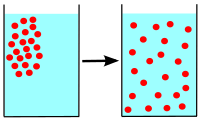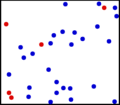Diffusion facts for kids
Diffusion is a physical process where molecules of a material move from an area of high concentration (where there are many molecules) to an area of low concentration (where there are fewer molecules).
Diffusion usually happens in a solution in gas or in a liquid. It is possible to see diffusion happening when two liquids are mixed in a transparent container. It describes the constant movement of particles in all liquids and gases. These particles move in all directions bumping into each other. Diffusion can only work with gases and liquids. Here are some examples of diffusion:
- A sugar cube is left in a beaker of water for a while.
- The smell of ammonia spreads from the front of the classroom to the back of the room.
- Fumes of perfume rise from the bottle when the top is removed.
- Food coloring dropped on the beaker spreads out.
Molecules tend to move from places of high concentration to places of low concentration, just by moving randomly. For example, there is more oxygen in a lung than there is oxygen in the blood so oxygen molecules will tend to move into the blood. Similarly, there is more carbon dioxide molecules in the blood than in the lung so carbon dioxide molecules will tend to move into the lung. It happens in cell biology, where small molecules simply diffuse through the cell membrane, but larger molecules only get through by using energy: see active transport.
Areas of high density are, due to the random movement of fluid molecules, likely to spread out within their boundary until they can do so no longer.
Images for kids
-
Diffusion from a microscopic and macroscopic point of view. Initially, there are solute molecules on the left side of a barrier (purple line) and none on the right. The barrier is removed, and the solute diffuses to fill the whole container. Top: A single molecule moves around randomly. Middle: With more molecules, there is a statistical trend that the solute fills the container more and more uniformly. Bottom: With an enormous number of solute molecules, all randomness is gone: The solute appears to move smoothly and deterministically from high-concentration areas to low-concentration areas. There is no microscopic force pushing molecules rightward, but there appears to be one in the bottom panel. This apparent force is called an entropic force.
See also
 In Spanish: Difusión (física) para niños
In Spanish: Difusión (física) para niños







